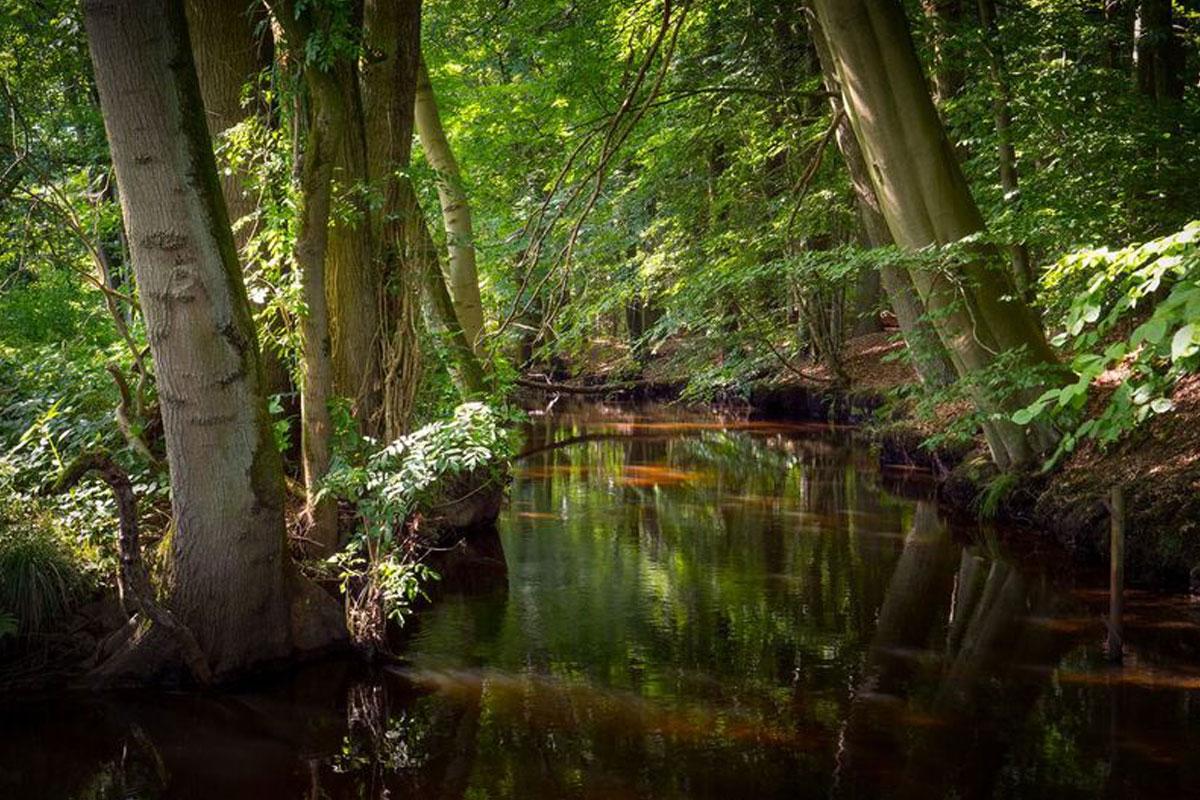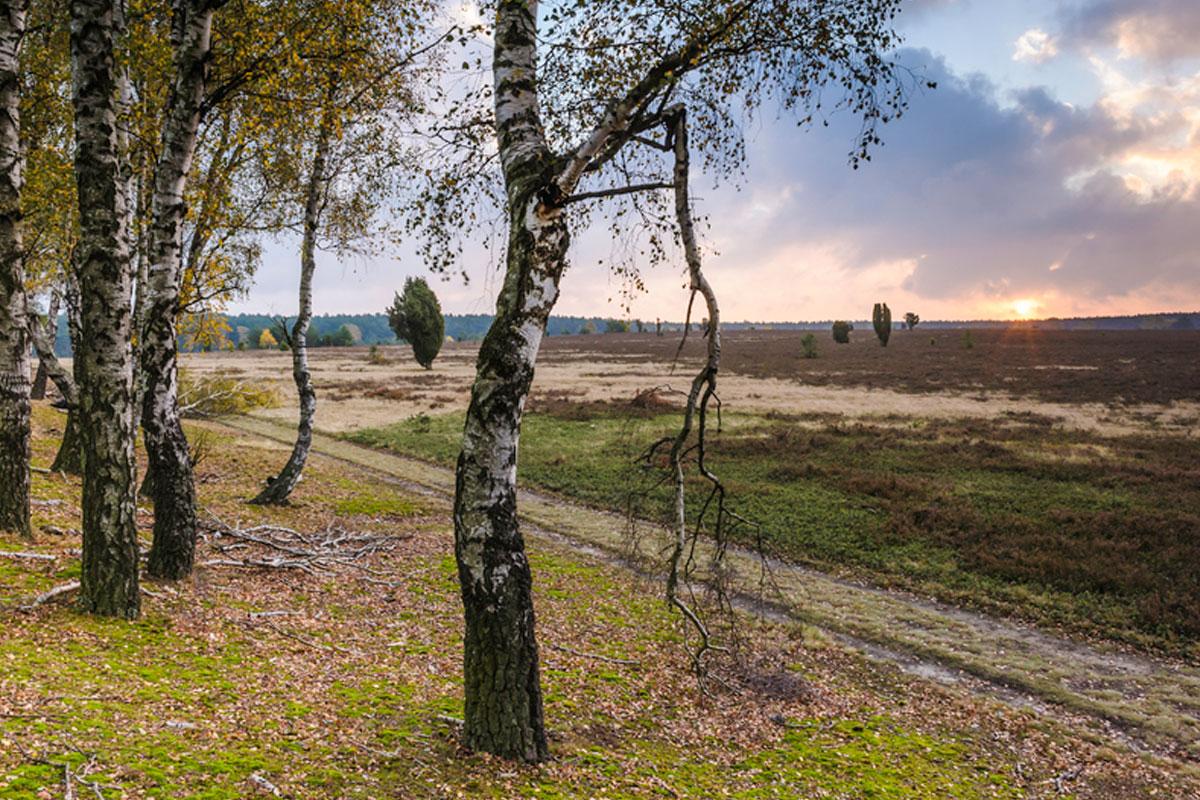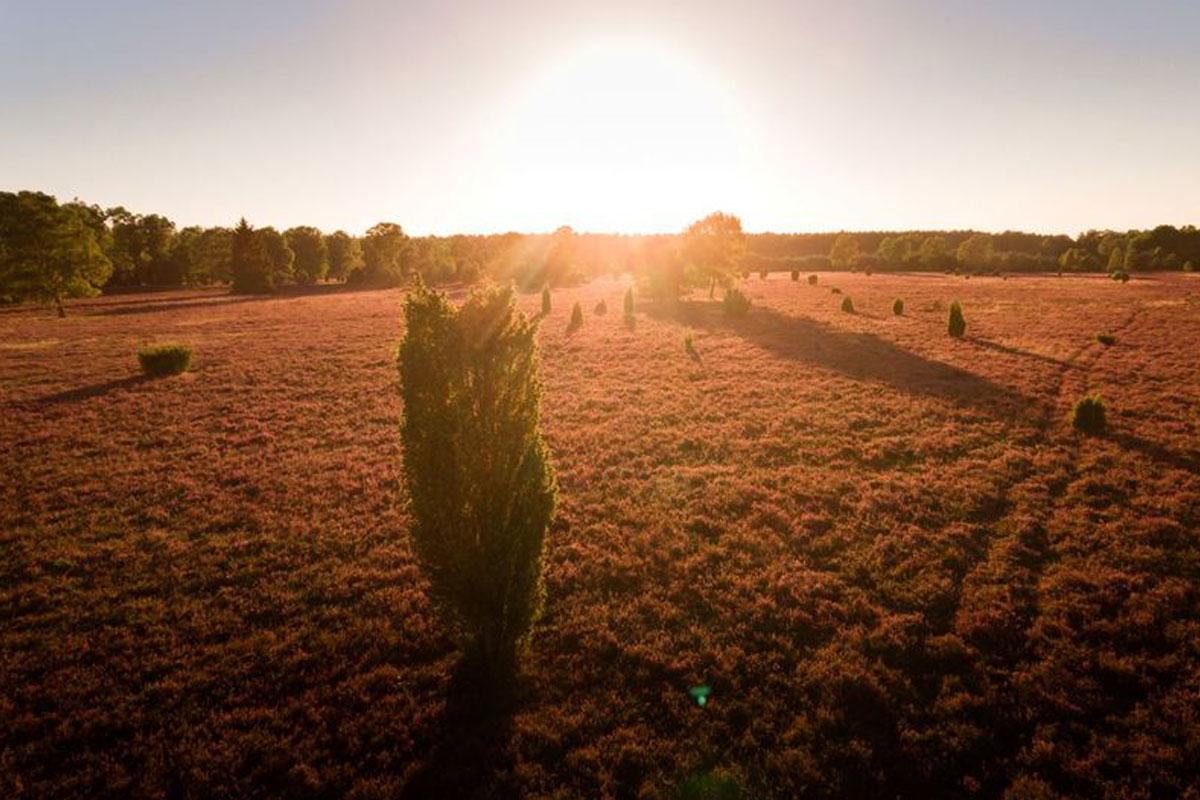Southern Heath Nature Park
Where pearls grow and the eagle soars























Origin of the glacial valleys through the ice age
The soils, geology and reliefs in Suedheide Nature Park are of glacial origin. During the penultimate Ice Age (Saale Ice Age), which ended about 130,000 years ago, the area of today's Nature Park was covered by huge ice masses, or glaciers. During the interglacial warm periods, these glaciers melted and retreated. They left behind sand, debris and boulders as ground, marginal and terminal moraines. As the glaciers retreated, numerous streams of meltwater formed and joined form glacial valleys. One of these is the glacial valley of the Aller and the Oertze with the characteristic lateral and valley moors. During one of these warm periods, the diatom deposits near Oberohe formed from the deposited shells of dead diatoms.
How did today’s diverse cultural landscape develop?
The lean, sandy soils created by the Ice Age in Suedheide Nature Park were covered by sparse mixed oak forests until the Middle Ages. Then they were almost completely deforested through human influence (logging, forest pasture, leaf litter utilization). Huge swathes of heathland developed on the nutrient-poor, sandy soil. The heather was constantly rejuvenated by gnawing sheep and peat-digging. It was only at the end of the 18th / beginning of the 19th century that large parts of the heath were reforested. These reforestation activities have led to the fact that Suedheide nature park today consists of 65% forest landscape.
The decline of the heathland was not only due to reforestation, but also the invention of mineral fertilizer. It helped improve the soil quality so that more of the once huge heathland was converted into agricultural land. The result of these developments led to the varied landscape of Suedheide Nature Park with the moors, heaths, forests and streams that make up its particular charm.
Where pearls grow and the eagle soars
The sparse landscape is also the reason why it is still thinly populated to this day. Only a few streets and tracks run through the nature park, so visitors will find quiet and almost undeveloped countryside. This tranquility and remoteness favours the occurrence of rare species such as cranes, otters, sea eagles and black storks, which are particularly sensitive to disturbances. At the same time, the Nature Park offers those seeking relaxation an ideal setting for hours of relaxed hiking and cycling, far away from mass tourism. Sometimes you can be here for hours on country roads without meeting a soul.
No doubt you have heard of the pearls of the South Seas, but what about the pearls from the South Heath? There is a pearl inside roughly every thousandth river pearl mussel. In the past, the mussels were abundant in the brooks and streams of the heath. Today, they face extinction.
The near-natural and nutrient-poor heather streams Oertze and Lachte offer a habitat for many endangered and very sensitive plant and animal species. Hence, you can navigate the Oertze by canoe only at certain times. Canoeing on smaller heather streams is no longer permitted. This benefits otters, brown trout, freshwater pearl mussels and many other species. Some of the streams are so important to the conservation of rare and endangered species that they are under protection – like the Weesener brook, for instance, that converges with the river Oertze in Hermannsburg.
In fact, the local heath rivers and their lowlands are protected areas of national and European importance. These include the rivers:
· Oertze
· Aschau
· Lachte
· Lutter
The river Lutter is the most valuable stream with regard to conservation. More than 160 endangered plant and animal species are native to it and its source areas. This is where you will find the last intact freshwater pearl mussel stocks of Central Europe.
The River Forest Adventure Trail that runs adjacent to the river Oertze is especially popular with young and old. It meanders alongside the Oertze from Poitzen (municipality of Fassberg) to Baven (municipality of Hermannsburg) over a total length of 20 km. Various circuit courses teach visitors a lot about the topics of "river" and "forest" at a number of hands-on stations.
Atmospheric heath landscape
The varied heathland of Suedheide Nature Park attracts countless lovers of nature to the southern Lueneburg Heath every year. Its attractions include:
The heath is a special visitor attraction, particularly in August, when the heather flowers in all its radiant purple splendor. But the sandy and dry heaths hold atmospheric landscape experiences in store during every season - like the juniper forest near Schmarbeck with its ancient gnarled juniper trees that are especially spooky in foggy conditions. Further heathland can be found on the Hausselberg hill. Its expansive heath areas offer magnificent views when the weather is good.
The Loensstein monument on Wietzer Berg near Mueden / Oertze is a very popular destination. In the midst of a park-like heath landscape stands a stone that was erected to commemorate the favorite place of the poet Hermann Loens. The largest contiguous heathland can be found around Oberohe on the unique diatomite circular route and in the Misselhorn Heath near Hermannsburg.
The district of Celle has for decades endeavoured to preserve and develop characteristic examples of this landscape. It has purchased or leased many heath areas. Almost all of these areas are now protected as nature reserves or as part of the European NATURA 2000 protected area system.
Four-legged conservationists
Suedheide nature park has three herds of Heidschnucken, or moorland sheep, that maintain and care for the heath. If you visit Misselhorn Heath, you may be lucky enough to meet the symbolic animal of the heath in the juniper forest and on Oberohe Heath.
Special tip: Visit the shepherd with his flock during the "sheep drive". Please see the Events Calendar for appointments.
Biking and hiking trails
Experience the most attractive scenery in our region on more than 400 kilometers of well-marked cycle paths. Gently undulating heathland, lake and river landscapes, sweeping meadows and deep forests as well as fascinating traces of (heath) history await you in Suedheide Nature Park and the entire Celle region. By the way, our bike tours are the best in the whole of Lower Saxony: in 2014, the district of Celle received an award for the most bicycle-friendly municipality in Lower Saxony from the Lower-Saxony Minister of Economic Affairs.
If you prefer to keep your feet firmly on the ground, the hiking paradise that is Suedheide has 23 themed hiking areas with short walks of 2 kilometers to day hikes of more than 20 kilometers. Get to know our breathtakingly beautiful natural and cultural landscape and its idyllic heathland. The Heidschnuckenweg, or Moorland Sheep Trail, is one of the Top Trails of Germany, as chosen by the readers of the hiking magazine in 2014. The Moorland Sheep Trail is integrated into the network of hiking trails in Suedheide Nature Park and can be combined with hiking tours to form large circular hiking trails. The region around Celle is therefore ideal as a location for round-trip hikes on the Moorland Sheep Trail.
Species-rich moorland
Suedheide nature park has extensive areas of moorland with a great diversity of species. Discover rare animal and plant species and observe fascinating natural spectacles such as the cotton grass blossom or the dance of the cranes. Special views of the mystical expanse of the moor landscape can be seen from the observation towers on Becklingen Moor near Bergen and Postmoor near Bargfeld.
Primeval forest landscapes
In addition to the heathland, Suedheide Nature Park is characterized above all by its wealth of sprawling coniferous and mixed forests. A biking or hiking tour in the shade of dense trees is pleasant, especially in high summer. But even in autumn, when the deciduous forests radiate in the most colourful hues, a trip to one of the forests in Suedheide Nature Park is highly recommendable. There is even a real "jungle" in the form of Luesswald Forest!
Discover the Südheide Nature Park in every season
Suedheide has its very own charm in every season of the year. A visit is therefore worthwhile in spring as well as in summer, in autumn and also in winter!
A special tip: you can experience breathtaking sunrises and sunsets in Suedheide. We will show you the best spots where you can watch this natural spectacle.
Barrier-free offers
Two sections of the Heidschnuckenweg are barrier-free hiking trails. The 1.4 km long barrier-free hiking tour next to the idyllic Angelbecksteich pond offers ideal conditions for people with impaired mobility or sight. The varied scenery with its quiet lake and the adjacent heathland surrounded by forest provides a very special experience of nature. Even a section of the popular River Forest Adventure Trail is completely barrier-free. It is located in the rustic heathland of Mueden (Oertze) and runs around Lake Heidesee. Of course, there are also barrier-free restaurants and accommodations in the heathlands - just ask at the local tourist information.
Rustic heath resorts
The heathland of Suedheide features many enchanting, traditional timber-framed houses, old farms and historic town centers. Visit interesting places like
· Eschede
· Faßberg
· Unterlüß
· Bergen
Purchase fresh products such as heather potatoes or heather honey directly from the region in the small farm shops of Suedheide! Of course, you can also enjoy freshly prepared regional specialties such as Heidschnucke (moorland lamb) or game dishes from the local forests in the numerous restaurants of the respective heathland. The hosts of Suedheide are looking forward to your visit!